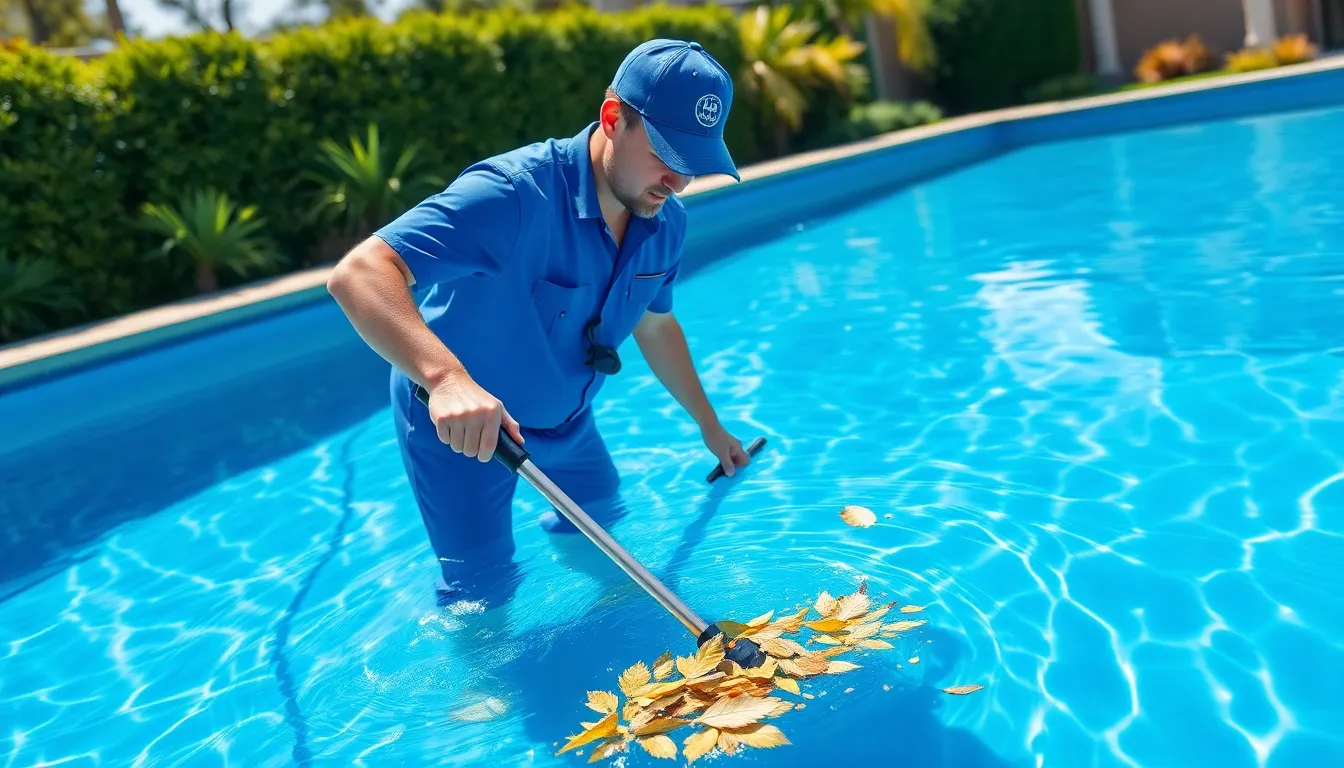Table of Contents
ToggleOwning a pool is like having a slice of paradise right in your backyard. But before diving into the crystal-clear waters, there’s a not-so-glamorous side to consider: monthly maintenance costs. Spoiler alert: it’s not just about lounging with a cocktail while the sun shines.
Imagine your pool as a high-maintenance diva demanding attention and a steady stream of cash. From chemicals to cleaning services, those expenses can add up faster than you can say “cannonball.” But don’t worry; understanding these costs can help you keep your pool sparkling without breaking the bank. Dive in as we explore the nitty-gritty of monthly pool maintenance costs and how to keep your aquatic oasis both beautiful and budget-friendly.
Understanding Monthly Pool Maintenance Cost
Owning a pool entails various ongoing expenses that contribute to its upkeep. Understanding these costs helps owners manage budgets effectively.
Factors Influencing Costs
Location significantly impacts monthly maintenance costs. Areas with high humidity often require additional chemical treatments to maintain water quality. Type of pool also plays a role. In-ground pools generally incur higher maintenance costs than above-ground options. Size affects the amount of chemicals and cleaning services needed. Bigger pools require more frequent maintenance. Seasonality can alter expenses. In colder months, some owners opt for winterization, while others may keep their pools running, leading to increased costs. Lastly, service frequency influences total expenses. Regular professional cleaning typically costs more than DIY efforts.
Average Cost Breakdown
Monthly pool maintenance costs generally vary between $100 and $400. Basic maintenance, which includes chemical balancing and cleaning, typically costs around $150. Chemical expenses account for 20% to 25% of total monthly costs, largely dependent on pool size and type. Equipment maintenance, covering filters and pumps, usually adds an extra $30 to $50 monthly. For those utilizing professional services, labor fees often contribute significantly, averaging $100 per visit. Homeowners should budget for seasonal needs as well, such as opening and closing services, which may raise average costs during those months.
Essential Pool Maintenance Services

Regular maintenance ensures a clean and safe swimming environment. Essential services encompass cleaning, chemical balancing, and equipment maintenance to manage costs effectively.
Cleaning Services
Cleaning services include skimming leaves, vacuuming debris, and scrubbing walls. Many professionals devote time to this crucial aspect, ensuring that pools remain inviting. Allowing dirt to accumulate can increase the risk of algae growth. The cost of cleaning services typically averages $100 to $150 per month, depending on the pool’s size and condition. Homeowners should consider frequency adjustments based on the pool’s usage. Regular cleaning not only enhances the pool’s appearance but also prolongs its lifespan.
Chemical Balancing
Chemical balancing involves testing and adjusting pH levels, chlorine content, and alkalinity. Maintaining water chemistry is vital for swimmer safety and equipment protection. Experts recommend routine testing every 1 to 2 weeks to keep water clear and safe. The monthly cost for chemical supplies generally ranges from $20 to $50, accounting for 20% to 25% of total maintenance expenses. Monitoring chemical levels helps prevent costly repairs and ensures compliance with health standards. Proper balancing enhances the swimming experience while safeguarding the pool structure.
Additional Costs to Consider
Pool ownership includes additional costs related to repairs, seasonal maintenance, and unexpected expenses. Planning for these can ensure effective budgeting and prevent financial surprises.
Equipment Repairs and Replacements
Equipment repairs are common in pool ownership. Over time, pumps, filters, and heaters may require fixes or outright replacements. Replacement costs can range significantly, with pumps costing $300 to $800 and heaters between $1,000 and $4,000. Regular inspections can help identify issues early, minimizing repair expenses. Investing in good-quality equipment tends to yield better longevity and performance, ultimately saving money. Homeowners should budget an extra $20 to $50 monthly for maintenance to reduce the risk of breakdowns and extend equipment lifespan.
Seasonal Maintenance
Seasonal maintenance impacts monthly pool costs, particularly during opening and closing months. Issues can arise due to temperature changes and increased debris. During opening, homeowners may spend an additional $200 to $500 to prepare their pools, which includes water balancing and equipment servicing. Closing a pool typically involves similar costs, and winterizing requires protective covers and chemical treatments. Allocating budget space for these seasonal tasks ensures smooth transitions between seasons, helping maintain water quality and equipment integrity throughout the year.
Cost-Saving Tips for Pool Owners
Managing pool maintenance costs requires strategic planning and informed decisions. Implementing effective cost-saving measures can significantly reduce monthly expenses.
DIY Maintenance Strategies
Performing maintenance tasks personally can lead to substantial savings. Regular skimming of debris minimizes cleaning service needs and keeps water clear. Testing water chemistry bi-weekly ensures balanced pH and chlorine levels, preventing expensive chemical treatments later. Purchasing pool maintenance kits often results in long-term cost reduction. Educating oneself on basic repairs can curb reliance on professionals for minor issues, like replacing a filter or gasket. Using online resources helps pool owners access tutorial videos or tips to improve their skills. Scheduling routine maintenance on non-peak days can also lower costs in professional service packages.
Choosing the Right Service Provider
Selecting the ideal service provider impacts overall maintenance costs. Comparing multiple companies can reveal price differences and service quality. Asking for customer references allows for insights into reliability and reputation. Seeking providers who use eco-friendly products can reduce chemical costs while promoting safety. Understanding service packages helps in identifying essential services and potential add-ons. Most companies offer free estimates; taking advantage of this can help identify the best rates. Contracting seasonal services instead of year-round may also lower monthly expenses without sacrificing pool quality.
Conclusion
Owning a pool comes with its share of responsibilities and costs. Understanding monthly maintenance expenses is crucial for effective budgeting. By recognizing the various factors that influence these costs and implementing smart strategies, pool owners can enjoy their oasis without breaking the bank.
Regular upkeep not only enhances the swimming experience but also prolongs the pool’s lifespan. With informed choices and a proactive approach, it’s possible to maintain a beautiful and safe pool environment while keeping expenses in check. Ultimately, investing time and resources into proper maintenance pays off in the long run, ensuring that the pool remains a source of joy and relaxation.




